The Ten Oxherding Pictures, commentary by Yu Gongbao (original) (raw)
ZEN IRODALOM ZEN LITERATURE ****« Zen index** « Home
普明 Puming:十牛圖 Shiniu tu
10 Steps Towards Enlightenment
Chinese Qigong Commentaryby Yu GongbaoExcerpt from the book ”Chinese Qigong Illustrated“ by Yu Gongbao, New World Press, Beijing, 1995, pp. 45-54.
http://small-steps-neijia.com/blog/?p=571
http://neigong.net/2011/08/28/the-ten-chan-pictures/
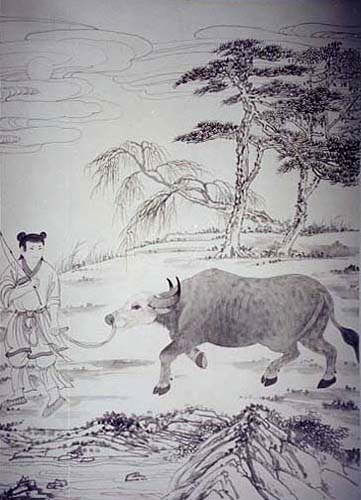
The Ten Chan Pictures
(1) In the Wild
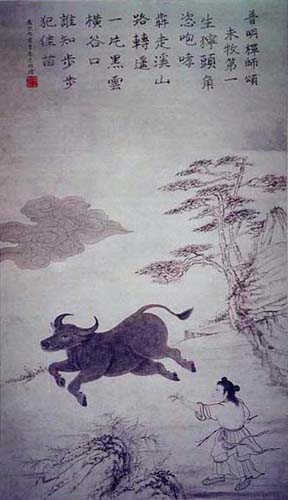
Troubled by all kinds of thoughts and desires, people are liable to get nervous anal disturbed in daily life and with their natural character confused and the ability to sustain themselves lost, they are quite ill with various worries and diseases. The poem reads:
Displaying its horns, the buffalo bellows aloud, Running along the mountain path into the distance. A patch of black clouds overhangs the valley, The buffalo tramples wheat seedlings wherever it goes.
(2) Initial Training
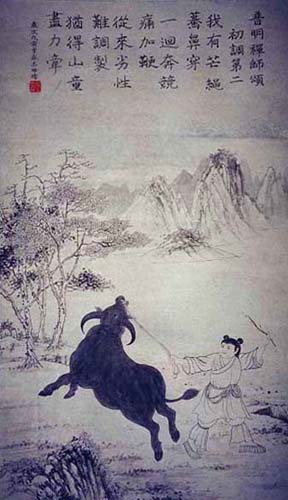
When you start qigong practice, place your mind under control and set strict demands on yourself, as if fastening the buffalo with a rope. After persistent practice, you will become disciplined and avoid unnecessary losses. The poem reads:
Controlled by a rope through its nose, The buffalo runs swiftly under the whip. It is no easy thing to overcome a willful temper, As the boy struggles hard to lead the buffalo.
(3) Under Control
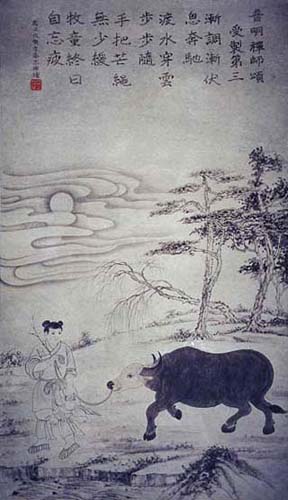
After some practice, you will find yourself calm and stable gradually. But you cannot slacken your efforts at this moment, anyway. Be sure to forget fatigue and feel at home. The poem reads:
Under constant training the buffalo stops dashing, Following the boy across streams and through clouds. Not daring to loosen the rope in his hand, The boy tends the buffalo all day in spite of his fatigue.
(4) Turning Back

When you reach a certain stage in practice, a turn for the better will take place and the destination of your life’s voyage will appear before you. In so doing, you can grow out of recklessness and act in conformity with nature. At this juncture, keep your mind steady and consolidate the original ring and strengthen the original qi. The poem reads:
A long time has passed before the buffalo turns back, Its reckless temper has gradually grown gentle. Not trusting the buffalo completely to itself, The boy has not yet unfastened the rope.
(5) Tamed
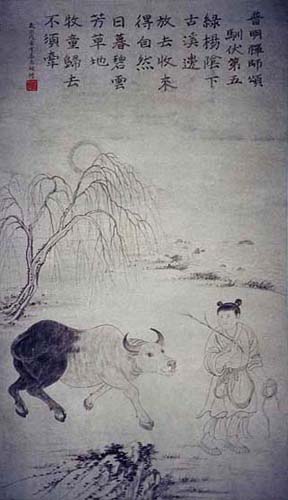
When you return to the true nature, you will enter a state of freedom; and when you combine the inside with the outside, you will not find yourself shrouded in dust any longer but see the light. Now that you have found your true character, you can do away with those strict demands. The poem reads:
Under the green poplar, by the ancient stream, The buffalo moves in harmony with nature. Returning at sunset over the fragrant meadow, The buffalo follows the boy, who has dropped his rope.
(6) Getting Free of Hindrance
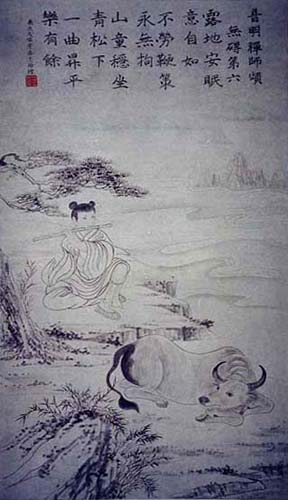
Getting free of hindrance is a state of penetration and evenness, and real control of both the body and the mind. Then try to enter a state of void through qi and shen practice and you will feel the inherent rhythm of life. The poem reads:
Sleeping contentedly under the sky, The buffalo needs the whip nevermore. The boy, sitting under the pine tree, Starts to play a peaceful, happy tune.
(7) In Control
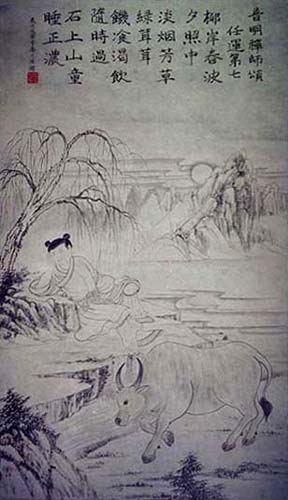
A man’s potential is boundless, and exploiting and making use of it will lay groundwork for the distillation of life. As the “buffalo” has been tamed and is free from worldly hindrance, it is time for you to enjoy the power of freedom and stroll in the realm of life. The poem reads:
Bathed in sunset, the river floats past the willow tree Under the fragrant meadow in light mist.’ Totally at ease, the buffalo drinks when thirsty, eat when hungry, And the boy is lying on a rock, deep in sleep.
(8) False Reality
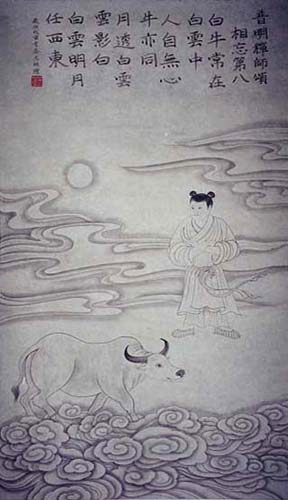
What is above everything is the true reality and observing various things in the world with a tranquil mind. Attaining the “union of man and heaven,” an advanced state in qigong practice, you will be in harmony with yourself and with nature. The poem reads:
The white buffalo stays in the white clouds; The boy is free of concern, and so is the buffalo. Penetrated by moonlight, the white clouds grow whiter; The moon goes its way, and the clouds drift by.
(9) Single Light
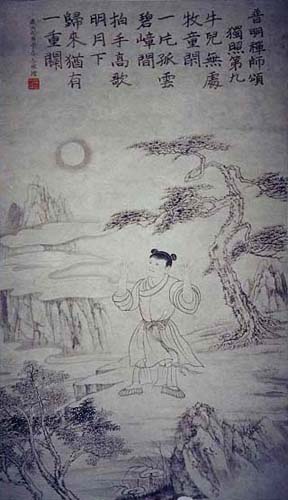
With the buffalo and its master in perfect harmony, there is not any difference between the outside and the inside. Shen merges with the body and willpower with qi. Whenever illumination comes, you will feel at ease and full of go and vigor. The poem reads:
After the buffalo has vanished, the boy enjoys leisure; A solitary cloud drifts across the hill. Clapping his hands, the boy sings under the moon, Though he has another portal to cross before reaching home.
(10) Rest in Sleep
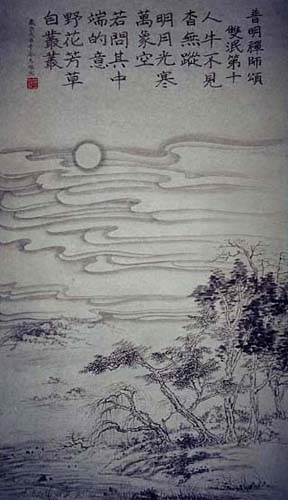
The mother of nature is formless, and everything may be back to the original purity and simplicity. The circle in the diagram shows a state of purity and perfection so that existence is non-existence and vice versa. Re-maining quiet and still, you will gain ultimate wisdom and enlightenment and the purification of your life will draw to an end. The poem reads:
Both the boy and the buffalo are nowhere to be found, The moon illuminates the vast void. If in search of the meaning of all this, Look at the wild flowers and fragrant grass.
Chan (meditation) is a state in which you gain wisdom and enlight-enment through self-cultivation. There are many methods of achieving this state, including zuochan, xingchan (walking quietly) and wuchan (contemplation). Self-cultivation is an advanced skill in Buddhist qigong. Bojo Guksa, a Buddhist monk living in the Ming Dynasty (1368-1644), wrote ten poems and drew ten pictures to describe the steps to enlightenment through contemplation. The buffalo in the pictures stands for the natural character of man or the source of life.
The Ten Chan Pictures (十禅图 , shí chán tú) also known as The Ox Herding Pictures originally comes from China.